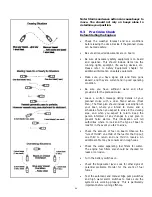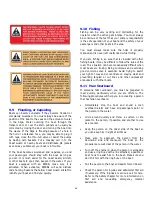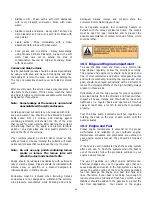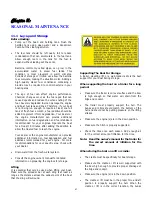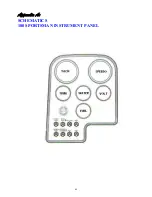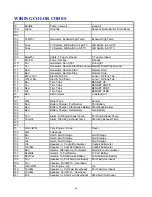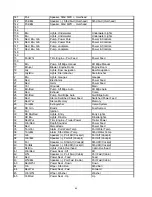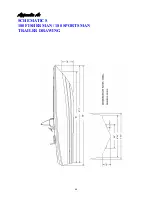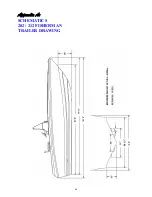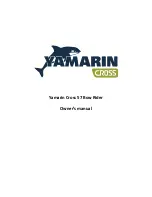
Pay special attention to the area just below the top on
powder coated frames. This area is subject to salt build
up from salty condensation and sea spray. It is also
frequently overlooked when the boat is washed and will
not be rinsed by the rain. Consequently, the powder
coating near fasteners and hardware mounted just
below the top is more likely to be attacked by the salt
and become corroded than the exposed areas on the
structure. Make sure the aluminum in this area is
washed frequently with soap and water and rinsed
thoroughly. Pay particular attention to places where the
top material contacts the frame.
Once a month check the entire frame for damaged
powder coating and corrosion around fasteners and
hardware. Nicked or badly scratched powder coating can
be sanded and touched up with enamel paint. Corrosion
around fasteners will have to be sanded, then touched
up with paint. The fasteners will require fiber washers
and sealing with caulk or a teflon based sealer to isolate
the fastener from the aluminum and prevent damage to
the paint or powder coating when the fastener is
installed. Periodically applying automotive or boat wax to
the powder coating will provide additional protection
from the harsh effects of saltwater.
Always repair scratches, nicks and corroded areas in
powder coating as soon as possible. Corrosion left
unaddressed will lift the powder coating allowing
moisture to travel between the powder coating and the
aluminum causing the corrosion to spread below the
coating and damage the aluminum.
If excessive chipping and peeling occurs, it could be an
indication of an electrical fault in the boat or aluminum
fabrication. You should contact a qualified marine
electrician to inspect your boat immediately and correct
the problem if you suspect that your boat may have a
fault in the aluminum frame. You should also contact
Wellcraft Customer Service.
Note: Boats that are towed behind larger vessels
require special attention to the aluminum
hardware. The salt spray, salty steam, and
chemicals in exhaust gases are
particularly corrosive and will eventually
penetrate and damage the surface of
anodized or powder coated aluminum. It is
imperative that the boat and the
aluminum are cleaned thoroughly at the
completion of each trip or at the end of
each day on long cruises to reduce
accelerated deterioration of the anodizing
or powder coating and premature
corrosion to the aluminum.
Note: You should contact Wellcraft Customer
Service before making any modifications
to aluminum fabrications. Unauthorized
modifications can void the warranty.
Chrome Hardware
Use a good chrome cleaner and polish on all chrome
hardware.
Acrylic Plastic Glass
Acrylic glass scratches easily. Never use a dry cloth or
glass cleaning solutions on acrylic. Use a soft cloth and
mild soap and water for routine cleaning. Solvents and
products containing ammonia can permanently damage
acrylic plastic glass.
Fine scratches can be removed with a fine automotive
clear coat polishing compound. A coat of automotive or
boat wax is beneficial to protect the surface.
Do not use the following on acrylic glass:
Abrasive cleaners
Acetone
Solvents
Alcohol
Glass cleaners
Cleaners containing ammonia
10.2 Upholstery, Canvas and Enclosures
Vinyl Upholstery
The vinyl upholstery used on the exterior seats and
bolsters, and for the headliner in the cabin should be
cleaned periodically with soap and water. Any stain, spill
or soiling should be cleaned up promptly to prevent the
possibility of permanent staining. When cleaning, always
rub gently. Avoid using products containing ammonia,
powdered abrasive cleaners, steel wool, strong solvents,
acetone and lacquer solvents or other harsh chemicals
as they can cause permanent damage or shorten the life
of vinyl. Never use steam heat, heat guns or hair dryers
on vinyl.
Stronger cleaners, detergents and solvents may be
effective in stain removal, but can cause either
immediate damage or slow deterioration. Lotions, sun
tan oil, waxes and polishes, etc., contain oils and dyes
that can cause stiffening and staining of vinyls.
The following are typical stains and cleaning tips
for vinyl:
• Dry soil, dust and dirt - Remove with a soft cloth.
• Dried on dirt - Wash with a soft cloth dampened
with water.
• Variations in surface gloss - Wipe with a water
dampened soft cloth and allow to air dry.
54
Summary of Contents for 180 Sportsman
Page 2: ...2...
Page 4: ...4...
Page 7: ...180 FISHERMAN SPECIFICATIONS 7...
Page 8: ...180 SPORTSMAN SPECIFICATIONS 8...
Page 9: ...202 FISHERMAN SPECIFICATIONS 9...
Page 10: ...212 FISHERMAN SPECIFICATIONS 10...
Page 18: ...18...
Page 39: ...SAFETY LABELS 2601 1124 39...
Page 40: ...180 FISHERMAN 180 SPORTSMAN CAPACITY LABELS 40...
Page 41: ...202 212 FISHERMAN CAPACITY LABELS 41...
Page 61: ...Appendix A SCHEMATICS 180 FISHERMAN INSTRUMENT PANEL 61...
Page 62: ...Appendix A SCHEMATICS 180 SPORTSMAN INSTRUMENT PANEL 62...
Page 63: ...Appendix A SCHEMATICS 202 212 FISHERMAN INSTRUMENT PANEL 63...
Page 68: ...Appendix A SCHEMATICS 180 FISHERMAN 180 SPORTSMAN TRAILER DRAWING 68...
Page 69: ...Appendix A SCHEMATICS 202 212 FISHERMAN TRAILER DRAWING 69...
Page 70: ...Appendix A SCHEMATICS 180 FISHERMAN OVERHEAD LAYOUT 70...
Page 71: ...Appendix A SCHEMATICS 180 SPORTSMAN OVERHEAD LAYOUT 71...
Page 72: ...Appendix A SCHEMATICS 202 FISHERMAN OVERHEAD LAYOUT 72...
Page 73: ...Appendix A SCHEMATICS 212 FISHERMAN OVERHEAD LAYOUT 73...
Page 77: ...MAINTENANCE LOG 77...
Page 78: ...MAINTENANCE LOG 78...
Page 80: ...Appendix D BOAT ACCIDENT REPORT 80...
Page 81: ...81...
Page 87: ...Appendix F TROUBLESHOOTING GUIDE 87...
Page 88: ...TROUBLESHOOTING GUIDE 88...
Page 89: ...TROUBLESHOOTING GUIDE 89...
Page 90: ...TROUBLESHOOTING GUIDE 90...
Page 91: ...TROUBLESHOOTING GUIDE 91...





